Dapeng Wu
NSF Center for Big Learning, University of Florida, Gainesville, FL
KLIPA: A Knowledge Graph and LLM-Driven QA Framework for IP Analysis
Sep 09, 2025Abstract:Effectively managing intellectual property is a significant challenge. Traditional methods for patent analysis depend on labor-intensive manual searches and rigid keyword matching. These approaches are often inefficient and struggle to reveal the complex relationships hidden within large patent datasets, hindering strategic decision-making. To overcome these limitations, we introduce KLIPA, a novel framework that leverages a knowledge graph and a large language model (LLM) to significantly advance patent analysis. Our approach integrates three key components: a structured knowledge graph to map explicit relationships between patents, a retrieval-augmented generation(RAG) system to uncover contextual connections, and an intelligent agent that dynamically determines the optimal strategy for resolving user queries. We validated KLIPA on a comprehensive, real-world patent database, where it demonstrated substantial improvements in knowledge extraction, discovery of novel connections, and overall operational efficiency. This combination of technologies enhances retrieval accuracy, reduces reliance on domain experts, and provides a scalable, automated solution for any organization managing intellectual property, including technology corporations and legal firms, allowing them to better navigate the complexities of strategic innovation and competitive intelligence.
KEPLA: A Knowledge-Enhanced Deep Learning Framework for Accurate Protein-Ligand Binding Affinity Prediction
Jun 16, 2025Abstract:Accurate prediction of protein-ligand binding affinity is critical for drug discovery. While recent deep learning approaches have demonstrated promising results, they often rely solely on structural features, overlooking valuable biochemical knowledge associated with binding affinity. To address this limitation, we propose KEPLA, a novel deep learning framework that explicitly integrates prior knowledge from Gene Ontology and ligand properties of proteins and ligands to enhance prediction performance. KEPLA takes protein sequences and ligand molecular graphs as input and optimizes two complementary objectives: (1) aligning global representations with knowledge graph relations to capture domain-specific biochemical insights, and (2) leveraging cross attention between local representations to construct fine-grained joint embeddings for prediction. Experiments on two benchmark datasets across both in-domain and cross-domain scenarios demonstrate that KEPLA consistently outperforms state-of-the-art baselines. Furthermore, interpretability analyses based on knowledge graph relations and cross attention maps provide valuable insights into the underlying predictive mechanisms.
Quaff: Quantized Parameter-Efficient Fine-Tuning under Outlier Spatial Stability Hypothesis
May 20, 2025Abstract:Large language models (LLMs) have made exciting achievements across various domains, yet their deployment on resource-constrained personal devices remains hindered by the prohibitive computational and memory demands of task-specific fine-tuning. While quantization offers a pathway to efficiency, existing methods struggle to balance performance and overhead, either incurring high computational/memory costs or failing to address activation outliers, a critical bottleneck in quantized fine-tuning. To address these challenges, we propose the Outlier Spatial Stability Hypothesis (OSSH): During fine-tuning, certain activation outlier channels retain stable spatial positions across training iterations. Building on OSSH, we propose Quaff, a Quantized parameter-efficient fine-tuning framework for LLMs, optimizing low-precision activation representations through targeted momentum scaling. Quaff dynamically suppresses outliers exclusively in invariant channels using lightweight operations, eliminating full-precision weight storage and global rescaling while reducing quantization errors. Extensive experiments across ten benchmarks validate OSSH and demonstrate Quaff's efficacy. Specifically, on the GPQA reasoning benchmark, Quaff achieves a 1.73x latency reduction and 30% memory savings over full-precision fine-tuning while improving accuracy by 0.6% on the Phi-3 model, reconciling the triple trade-off between efficiency, performance, and deployability. By enabling consumer-grade GPU fine-tuning (e.g., RTX 2080 Super) without sacrificing model utility, Quaff democratizes personalized LLM deployment. The code is available at https://github.com/Little0o0/Quaff.git.
FedRTS: Federated Robust Pruning via Combinatorial Thompson Sampling
Jan 31, 2025



Abstract:Federated Learning (FL) enables collaborative model training across distributed clients without data sharing, but its high computational and communication demands strain resource-constrained devices. While existing methods use dynamic pruning to improve efficiency by periodically adjusting sparse model topologies while maintaining sparsity, these approaches suffer from issues such as greedy adjustments, unstable topologies, and communication inefficiency, resulting in less robust models and suboptimal performance under data heterogeneity and partial client availability. To address these challenges, we propose Federated Robust pruning via combinatorial Thompson Sampling (FedRTS), a novel framework designed to develop robust sparse models. FedRTS enhances robustness and performance through its Thompson Sampling-based Adjustment (TSAdj) mechanism, which uses probabilistic decisions informed by stable, farsighted information instead of deterministic decisions reliant on unstable and myopic information in previous methods. Extensive experiments demonstrate that FedRTS achieves state-of-the-art performance in computer vision and natural language processing tasks while reducing communication costs, particularly excelling in scenarios with heterogeneous data distributions and partial client participation. Our codes are available at: https://github.com/Little0o0/FedRTS
EPIDetect: Video-based convulsive seizure detection in chronic epilepsy mouse model for anti-epilepsy drug screening
May 31, 2024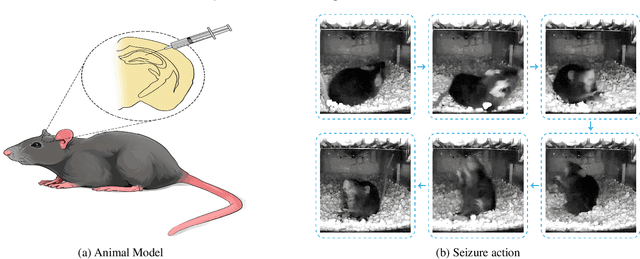
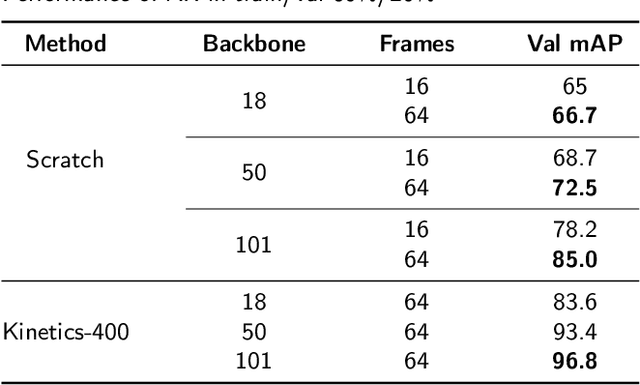

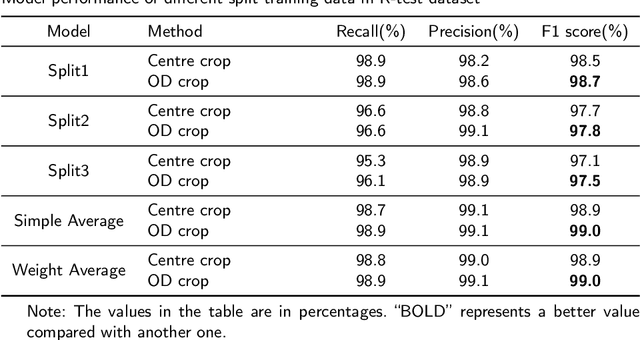
Abstract:In the preclinical translational studies, drug candidates with remarkable anti-epileptic efficacy demonstrate long-term suppression of spontaneous recurrent seizures (SRSs), particularly convulsive seizures (CSs), in mouse models of chronic epilepsy. However, the current methods for monitoring CSs have limitations in terms of invasiveness, specific laboratory settings, high cost, and complex operation, which hinder drug screening efforts. In this study, a camera-based system for automated detection of CSs in chronically epileptic mice is first established to screen potential anti-epilepsy drugs.
scBiGNN: Bilevel Graph Representation Learning for Cell Type Classification from Single-cell RNA Sequencing Data
Dec 16, 2023Abstract:Single-cell RNA sequencing (scRNA-seq) technology provides high-throughput gene expression data to study the cellular heterogeneity and dynamics of complex organisms. Graph neural networks (GNNs) have been widely used for automatic cell type classification, which is a fundamental problem to solve in scRNA-seq analysis. However, existing methods do not sufficiently exploit both gene-gene and cell-cell relationships, and thus the true potential of GNNs is not realized. In this work, we propose a bilevel graph representation learning method, named scBiGNN, to simultaneously mine the relationships at both gene and cell levels for more accurate single-cell classification. Specifically, scBiGNN comprises two GNN modules to identify cell types. A gene-level GNN is established to adaptively learn gene-gene interactions and cell representations via the self-attention mechanism, and a cell-level GNN builds on the cell-cell graph that is constructed from the cell representations generated by the gene-level GNN. To tackle the scalability issue for processing a large number of cells, scBiGNN adopts an Expectation Maximization (EM) framework in which the two modules are alternately trained via the E-step and M-step to learn from each other. Through this interaction, the gene- and cell-level structural information is integrated to gradually enhance the classification performance of both GNN modules. Experiments on benchmark datasets demonstrate that our scBiGNN outperforms a variety of existing methods for cell type classification from scRNA-seq data.
Spatial-Temporal DAG Convolutional Networks for End-to-End Joint Effective Connectivity Learning and Resting-State fMRI Classification
Dec 16, 2023Abstract:Building comprehensive brain connectomes has proved of fundamental importance in resting-state fMRI (rs-fMRI) analysis. Based on the foundation of brain network, spatial-temporal-based graph convolutional networks have dramatically improved the performance of deep learning methods in rs-fMRI time series classification. However, existing works either pre-define the brain network as the correlation matrix derived from the raw time series or jointly learn the connectome and model parameters without any topology constraint. These methods could suffer from degraded classification performance caused by the deviation from the intrinsic brain connectivity and lack biological interpretability of demonstrating the causal structure (i.e., effective connectivity) among brain regions. Moreover, most existing methods for effective connectivity learning are unaware of the downstream classification task and cannot sufficiently exploit useful rs-fMRI label information. To address these issues in an end-to-end manner, we model the brain network as a directed acyclic graph (DAG) to discover direct causal connections between brain regions and propose Spatial-Temporal DAG Convolutional Network (ST-DAGCN) to jointly infer effective connectivity and classify rs-fMRI time series by learning brain representations based on nonlinear structural equation model. The optimization problem is formulated into a continuous program and solved with score-based learning method via gradient descent. We evaluate ST-DAGCN on two public rs-fMRI databases. Experiments show that ST-DAGCN outperforms existing models by evident margins in rs-fMRI classification and simultaneously learns meaningful edges of effective connectivity that help understand brain activity patterns and pathological mechanisms in brain disease.
Deep Learning Enables Large Depth-of-Field Images for Sub-Diffraction-Limit Scanning Superlens Microscopy
Oct 27, 2023



Abstract:Scanning electron microscopy (SEM) is indispensable in diverse applications ranging from microelectronics to food processing because it provides large depth-of-field images with a resolution beyond the optical diffraction limit. However, the technology requires coating conductive films on insulator samples and a vacuum environment. We use deep learning to obtain the mapping relationship between optical super-resolution (OSR) images and SEM domain images, which enables the transformation of OSR images into SEM-like large depth-of-field images. Our custom-built scanning superlens microscopy (SSUM) system, which requires neither coating samples by conductive films nor a vacuum environment, is used to acquire the OSR images with features down to ~80 nm. The peak signal-to-noise ratio (PSNR) and structural similarity index measure values indicate that the deep learning method performs excellently in image-to-image translation, with a PSNR improvement of about 0.74 dB over the optical super-resolution images. The proposed method provides a high level of detail in the reconstructed results, indicating that it has broad applicability to chip-level defect detection, biological sample analysis, forensics, and various other fields.
FedTiny: Pruned Federated Learning Towards Specialized Tiny Models
Dec 05, 2022



Abstract:Neural network pruning has been a well-established compression technique to enable deep learning models on resource-constrained devices. The pruned model is usually specialized to meet specific hardware platforms and training tasks (defined as deployment scenarios). However, existing pruning approaches rely heavily on training data to trade off model size, efficiency, and accuracy, which becomes ineffective for federated learning (FL) over distributed and confidential datasets. Moreover, the memory- and compute-intensive pruning process of most existing approaches cannot be handled by most FL devices with resource limitations. In this paper, we develop FedTiny, a novel distributed pruning framework for FL, to obtain specialized tiny models for memory- and computing-constrained participating devices with confidential local data. To alleviate biased pruning due to unseen heterogeneous data over devices, FedTiny introduces an adaptive batch normalization (BN) selection module to adaptively obtain an initially pruned model to fit deployment scenarios. Besides, to further improve the initial pruning, FedTiny develops a lightweight progressive pruning module for local finer pruning under tight memory and computational budgets, where the pruning policy for each layer is gradually determined rather than evaluating the overall deep model structure. Extensive experimental results demonstrate the effectiveness of FedTiny, which outperforms state-of-the-art baseline approaches, especially when compressing deep models to extremely sparse tiny models.
Server Averaging for Federated Learning
Mar 22, 2021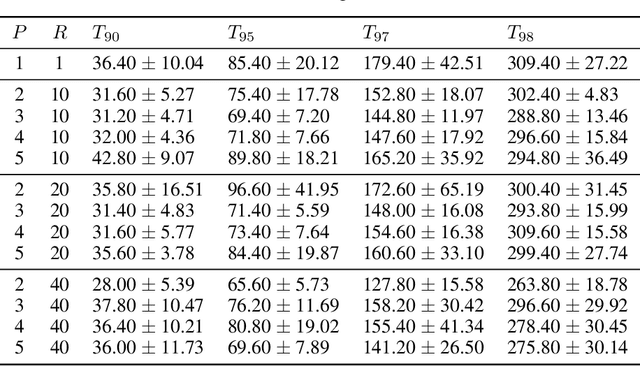
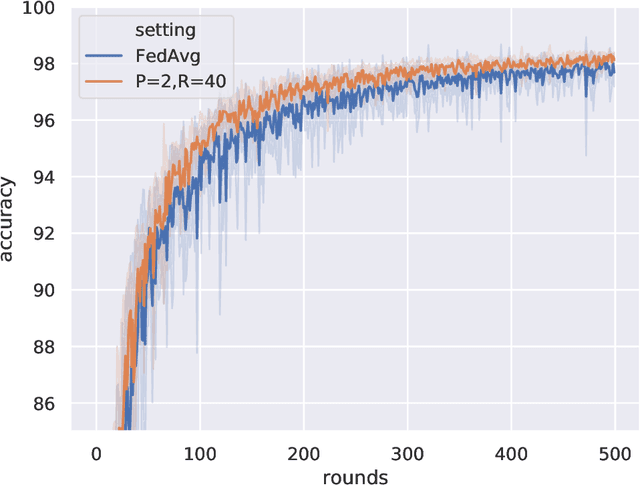

Abstract:Federated learning allows distributed devices to collectively train a model without sharing or disclosing the local dataset with a central server. The global model is optimized by training and averaging the model parameters of all local participants. However, the improved privacy of federated learning also introduces challenges including higher computation and communication costs. In particular, federated learning converges slower than centralized training. We propose the server averaging algorithm to accelerate convergence. Sever averaging constructs the shared global model by periodically averaging a set of previous global models. Our experiments indicate that server averaging not only converges faster, to a target accuracy, than federated averaging (FedAvg), but also reduces the computation costs on the client-level through epoch decay.
 Add to Chrome
Add to Chrome Add to Firefox
Add to Firefox Add to Edge
Add to Edge